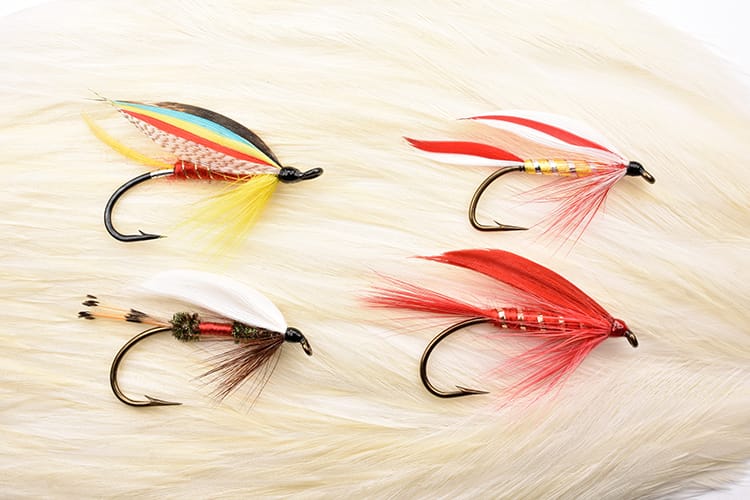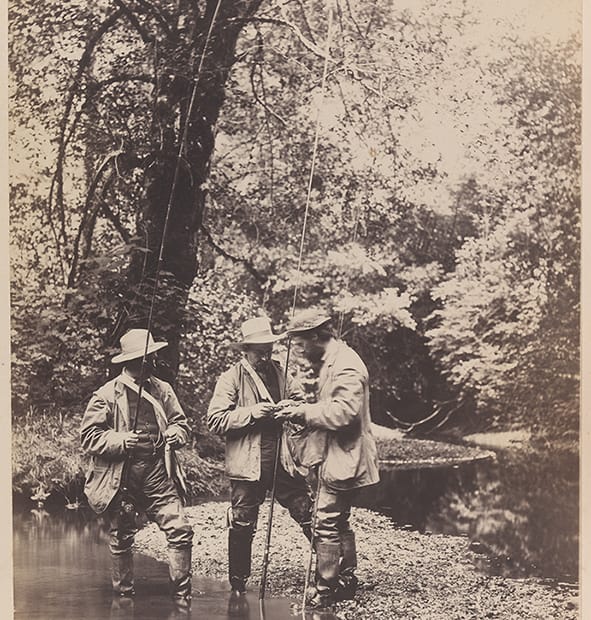Steel · head · er – noun, a person who fishes for anadromous rainbow trout, commonly called steelhead, often with fly fishing tackle.
Early History
The California Gold Rush brought immigrants from all over the world to California. It is likely some of them were anglers who brought fishing tackle and techniques with them. Others were longtime residents whose families were early California pioneers. Some of these individuals were to become the first steelheaders.
Living was difficult in the 1800’s and time for leisure activities limited. One of the first written accounts of fishing in California was published in 1852 in the Sacramento Daily Union newspaper which began publication in 1851. The article reported:
A Chinaman was seen fishing in the Slough yesterday for the first time, with a set attached to bamboo. He appeared to have been endowed with the patience of an Ike Walton.
It is likely this early angler was fishing for one of several native minnows common to the Sacramento/San Joaquin Delta. In the following years reports of trout fishing began to appear in newspapers. In 1854, the same Sacramento Daily Union described a fishing location and scene just fifty miles east of Sacramento:
One of the finest trout streams (referring to Sly Park Creek, El Dorado County, tributary to the North Fork Cosumnes River) in California, with its eddying pools and laughing cascades all combined makes it one of earths loveliest spots.
Salmon were abundant in many California Coastal and Central Valley rivers. However, they were most often caught by commercial fishing methods such as nets and seines.
The First Steelheaders
Trey Combs in The Steelhead Trout (1971) wrote the Eel River gave us our steelheading birthplace. In October 1887, the Ferndale Enterprise newspaper provided an account of a group of anglers fishing the Eel River:
The S.F. Examiner, in an account of the recent fishing trip of C.G. Young, E.S. Van Slyke, John Butler, Jno. Gallagher, John Benn, and A. Shattuck of that city, to Eel river says: The fishing during the warm portion of the day is done with a spoon, but after three o’clock the fly was used. Benn’s Royal Coachman proved a success and on it the men took both trout and salmon, some of the latter weighing 20 pounds. Butler and Van Slyke made the banner catch of the trip, killing 147 fish in weight from half a pound to fifteen pounds.
Jno. Benn took 55 trout in one afternoon, the largest weighing 11 pounds. The work was done with a fly. Gallagher, who was the last of the party to return, reached S.F. with 60 pounds of fish, the result of one day’s catch. This lot did not average as large as some of the catches but were of uniform size, being from one-half to three pounds in weight. John Butler reports the water lower than for years and the fishing better than it has ever been.
Young, Slyke and Butler
This early group of steelheaders included several early California fly anglers. The first mentioned was Charles G. Young, a member of the San Francisco Fly Casting Club who later participated in casting contests from 1902 to 1909. Elisha S. Van Slyke, another member of the 1887 fishing group was born in 1854 and died in 1900 at the age of 45. Other than the brief 1887 newspaper report, little additional information on the fishing adventures of these two first steelheaders can be found in early newspapers. A third individual mentioned was John Butler, another San Francisco angler and also a member of the San Francisco Fly Casting Club. Reports indicate he fished the Eel River as early as 1884.
At that time, half-pounder and adult summer steelhead, and winter steelhead were plentiful in the Eel River. The abundant runs provided excellent fishing opportunities. Back then, the lower river was deep and wide. Anglers most often cast and trolled flies from wooden row boats. Eel River fly patterns were often imported Eastern trout wet flies and occasionally Atlantic salmon patterns.

Early flies
The first steelheaders used flies such as the Kate, Royal Coachman, Parmacheene Bell and Red or Scarlet Ibis. The Kate was a European Atlantic Salmon pattern developed in the mid-1800’s and credited to Mrs. Courtney; the Royal Coachman was first tied by John Haily from New York in 1878; and the Parmacheene Belle was created by Henry P. Wells of Providence, Rhode Island, sometime prior to 1890. The origin of the Red or Scarlet Ibis is unknown but likely originated during the Victorian era in the late 1800’s.
John Gallagher
Another angler in the 1887 group was Jno. (John) Gallagher, a resident of Oakland. Several years later in September 1896 the San Francisco Call newspaper reported Gallagher:
Now on the Eel, and according to latest reports those noted disciples of steelhead and “Walton” are having the grandest sport imaginable trolling for the new arrivals from the deep, deep sea.
Gallagher continue to fish for steelhead and was also reported to have caught “seven large steelhead in the tide waters of Paper Mill Creek” in the March 19, 1898 San Francisco Call newspaper. Little historical information is available about A. Shattuck, another member of the early group. However, the Shattuck’s were a prominent Berkely family in the late 1800’s.

John S. Benn
The final member of the 1887 fishing party was John S. Benn, the most famous of the first steelheaders. Benn was born in Ireland and immigrated to the United States in 1850. He later settled in San Francisco in the late 1800’s and often traveled by steamship to Eureka to fly fish the lower Eel River. He and other visiting anglers often stayed at the Weymouth Inn, located on the Grizzly Bluff upstream of the confluence with the Van Duzen River, or at the Greig Resort, located near Fernbridge. In October 2, 1903, the Ferndale Enterprise reported:
J.S. Benn, the noted expert fly maker, arrived on the Eureka Sunday and will try some of his own materials in attempting to lure the finny denizens of Eel River in the vicinity of Weymouth’s”.
Benn later gained fame when the June 9, 1907, San Francisco Sunday Call newspaper magazine section featured him on the cover. The accompanying article described him as the “father of fishing in California.”
Benn is credited with creating several flies for the Eel River, including the Benn’s Coachman, referred to as Benn’s Royal Coachman in the newspaper. Many writers credit Benn with creating the Humboldt Railbird pattern. However, Joseph D. Bates Jr., in Steamer Fly Tying and Fishing (1950 and 1966) indicated A.J. McClane, then fishing editor for the Field and Stream magazine, suggested the Railbird Steelhead fly was created after Jim Hutcheson used a Kate fly in or about 1915 while fishing the lower Eel River. Hutcheson was catching fish and when asked what fly he was using replied “railbird,” slang for a person who tends to watch “from the rail” rather than actually participating. A local angler later sent the fly to Martha Benn to have additional flies tied. Martha did not have all the necessary materials and improvised naming the new creation the Humboldt Railbird.
Other early anglers
Other San Francisco sportsmen including John Gallagher and Lloyd Eaton, both well-known San Francisco residents, fished the Eel River. They not only fished the Eel River but also fished for trout in the local streams around the San Francisco Bay area. The San Francisco Call reported in May 1894:
John Butler and Lloyd Eaton returned last evening from Mateo County with a splendid mess of mountain trout. As the anglers are members of the scientific class, it is presumed that the fishes were caught on the fly.
Not all early steelhead anglers made the long trip to the Eel River to fish for steelhead. Several Humboldt Bay residents fished the Eel River including Charles Parsons Soule, Josh Vansant Jr., Charles Sumner Carson. Soule was an organizer and President of the Humboldt Chamber of Commerce in the early 1900’s, a cashier for the Bank of Eureka in the late 1800’s and later became president of the bank in 1908. The Soule is a fly pattern similar to the Parmacheene Belle. The fly is credited to San Francisco fly tyer San John S. Benn.

Vansant and Culbert
Josh Vansant Jr. was a Eureka resident and photographer credited with originating the Van Vansant fly pattern. He is mentioned in a February 1898 San Francisco Call newspaper article. Vansant’s angling companion, W.C. Culbert, was an early paper pioneer in the San Francisco Bay area. This illustration of a large catch of what appears to be half-pounder steelhead accompanied the February 1898 newspaper article:
TROUT FISHING ON EEL RIVER. The beautiful Eel River, in Humboldt County, is affording anglers gala sport owing to the low and clear state of the water and the large numbers of game fishes that are lodged in the deep pools waiting opportunity to ascend to spawning bed? Recently J. Vansant Jr., the photographer of Eureka, Cal., and W. C. Culbert, of the S. B. Leavitt Paper Company of this city, enjoyed a few days of grand sport, catching fourteen-inch steelheads with hook and line.
On January 11 they basketed forty-one nice fish which were photographed by Mr. Vansant. The best fishing grounds are between Singleys and Ferndale, which place can be reached from Eureka by team or train, a distance of sixteen miles. Although rather late in the season for trout fishing, the twenty-seven and a half pound catch made by the gentlemen in question proves beyond a doubt that first-class midwinter sport can be enjoyed by anglers until such time as the heavy rains will disturb and alter the present condition of the clear and sparkling waters of the river.
Charles Sumner Carson is associated with the Carson, or Carson Royal Coachman fly. This fly is also credited to John S. Benn. The Carson fly is similar to the Royal Coachman pattern but includes a red strip in the wing. The Carson family was a prominent Eureka family. The famous Carson Mansion in Eureka was built by Sumner Carson’s father. The mansion is the most written about and photographed Victorian house in California and has served as a model for many haunted mansions.
Leading the way
These early steelheaders set the stage for the next 100 years of steelhead fly fishing. As knowledge of the runs of steelhead and salmon in California’s North Coast rivers became more common, other anglers began exploring California rivers and creeks further south. Readers can find more information about the history of these rivers and the anglers who fished them in California Winter Steelhead, Life History and Fly Fishing (2021), available at www.dennisplee.com.
For other historical blog information check out these blogs:
“a fly for a gigantic Christmas steelhead”; and “early California winter steelhead flies – some unique information.”
